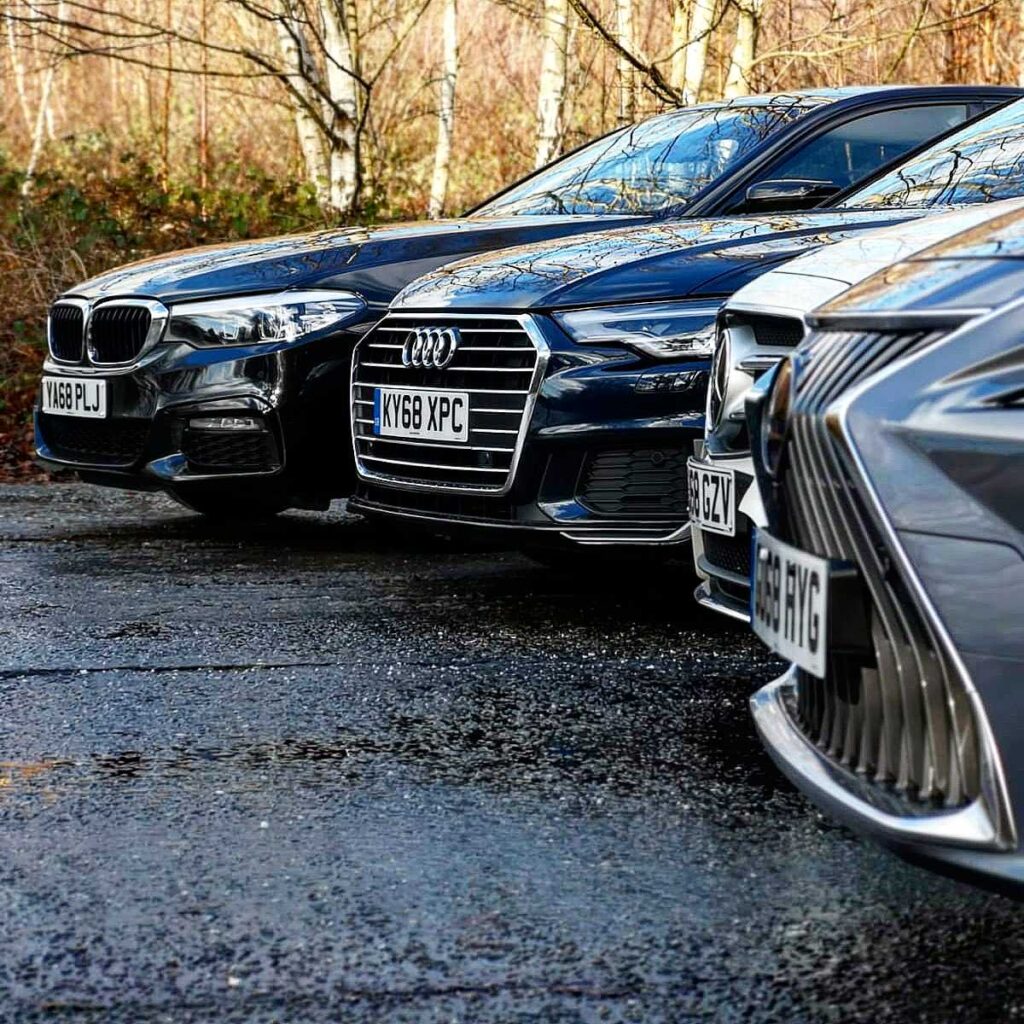Traditional luxury sedans need to do it all. They must be practical, sporty, luxurious, quick and efficient, at the same time pampering and impressing all who are aboard. So which does this better, BMW’s 5 Series or Audi‘s new A6?

When it comes to luxury cars, German brands spring first to mind. There are other choices, of course, though these remain alternatives so far as most Kiwi buyers are concerned. The likes of the BMW 5 Series and Audi A6 sedans compete in the middle ground of the luxury market, appealing to the traditionalist who doesn’t want a contrives, four-door coupe or a hunchbacked GT. And they need to do it all, play limo one day, sports sedan the next, while offering a premium experience at all times.
Last year, we picked the new 5 Series over Jaguar’s XF and Merc’s E-Class, but one player was missing from that stoush, the Audi A6. Now there’s new A6 model on the market, a much improved offering, and the time has come to line it up against the current 5 Series.
As we have a fully kitted 535d up against an A6 TFSI, it isn’t an ideal comparison, but you know what they say about best laid plans… Handily, we piloted the 535i and A7 TDI over these exact roads not so long ago, so can draw on our experience of both the petrol and diesel versions of these models.
What you get for your cash
If you’ve got $140,000 to spend on your next car, the 5 Series and A6 model line each offers a diesel or petrol six-cylinder option. Audi charges the same for both, $143,900, which is a substantial $22k increase over the outgoing model but in line with BMW‘s pricing of the 535i at $146,500 and the 535d at $148,500.
Whether you choose petrol or diesel the specification level is the same, and both brands offer a similar standard kit. Expect 18-inch alloys, a rear-view camera, parking sensors front and rear, auto xenon headlights (with auto high-beam dip on the BMW), auto wipers sat nav, Bluetooth, upgraded stereos, leather trim, electric seat adjust (Audi includes seat heaters), dual-zone climate air and cruise control.
BMW adds keyless entry and a head-up display, both of which are optional on the A6. As you would expect, airbags and stability control are standard features, though the likes of lane departure and radar braking systems are optional extras. In fact, there are plenty of options for each, and these can quickly escalate the price. For instance, the 535d pictured costs $165k.
The mechanical differences
The 5 Series range offers a choice of four-,six- and eight- cylinder engines, the pick being the twin-turbo 3.0-litre diesel in the 535d. There are three A6′s on offer, the supercharged petrol V6 tested here and two 3.0-litre V6 diesel, which differ in output and specification. We prefer the Audi’s charged V6 to the BMW’s turbocharged petrol as it offers more torque and a better throttle response. But with their better mix of performance and economy, the big, smooth, torquey diesel sixes accounts for Audi’s V6 TDI. It’s not scared to rev, and its abundance of torque flows from idle to cut-out. In December, a bi-turbo V6 TDI producing 230kW and 650Nm arrives from Audi, so you might want to wait for that. We would.
The all-wheel-drive system of the A6 is vastly improved this time around thanks to a new mechanical centre diff. While it usually divvies the torque up 40:60 front to rear, it can vary this and send as much as 70 per cent to the front or 85 per cent rearwards. The result is hugely improved dynamics. In comparison, the 5 uses a traditional rear-drive approach, which delivers a better chassis balance but has to rely on electronic traction control to stem the flow of the overactive Newton metres. Those intent on settings a new record for the trip to the bach in the A6 can option in the rear sports diff, which all but banishes understeer, while the BMW owner can enhance the handling with adaptive dampers and active sway bars, which flatten out the body lean, enabling the car to manoeuvre more eagerly.
Drivers of the 5 have ZF’s eight-speed auto working for them, with its near-telepathic shifting protocols, where those in the Audi use a seven-speed twin-clutch auto. This is impressive, too, and has a refined action at low speeds not usually associated with a transmission of this type. Though its shift quality isn’t as liquid smooth as the BMW’s auto, its manual shifts are enacted more quickly. Drivers of both cars can tailor the steering, throttle and gearbox behaviour to their liking.
BMW’s latest 5 is a larger car than the model it replaces, nut is also heavier – to the tune of 100kg in the case of the 535d if compared to the E60. In spite of this, it’s quicker and consumes less fuel, a result of the fuel-saving initiatives of its super-efficient engine and multi-speed gearbox. Check out its petrol-slaying performance figures in the spec sheet. The latest TFSI, too, is more efficient, improving by a claimed 1.2L/100km, and it is also more powerful, reaching 100km/h 0.7 of a second quicker. And Audi has delivered a better-package A6.
Though slightly shorter overall, it has a longer wheelbase, benefiting interior space. It’s a stronger, safer car, with more features, yet according to our scales, it’s 24kg lighter than the model it replaces, meaning it has levelled the playing field with the BMW on mass, if not chassis balance. Couple this with the improved driveline and the fact the latest 5 has moved its focus more towards comfort and refinement, and much closer contest results on the dynamics front.
How did they go then?
These cars cover long distance with ease. Both are quiet, ride well on the highway and have excellent touring ranges because of their overdriven gearing. Easy overtaking is just a stomp of the throttle away.
Most A6 buyers will sign up for the S Line package, gaining fancy-looking alloys and sporty suspension, and in so doing missing out on the commendable ride-and-handling mix of this as-standard car. While the Beemers can be optioned with dynamic damping to deliver a very cushy ride, our M-kitted car was certainly firmer than the Audi.
Because of its weird steering and propensity for understeer, we’ve never rated the dynamics of the A6 highly, but this is no longer the case. You can get on the gas and drive the car through a bend now, the variable torque bias keeps the nose from pushing on, with no intervention from the traction control. Neither brand struggles for lateral grip in a corner – certainly not this BMW – but the quattro A6 has a marked traction advantage, which is amplified on wet roads.
The Audi, in its guise here at least, absorbs the bumps better, too. When taking the photos for these pages, we found that a series of dips and bumps leading into the bend caused problems for the BMW, but the Audi rode straight over them. The BMW steers better, however, while the Audi is still slightly disappointing in this area. The same with the brakes: the BMW has the more tactile pedal. Which is not to say that the A6 is devoid of feel; it lets you know when you’ve pushed too hard, and allows for slight adjustments rather than calling all to a halt with harsh ESP intervention. An A7 kitted out with masses of optional rubber driven over these same roads proved almost unstickable, yet it gave nothing back in terms of feel.
Interior comforts
These two offer the benefits of a large car and the sort of space that makes you wonder why you’d ever want anything as big as the A8 or 7 Series (unless you’ve a chauffeur to call on). Up front, it’s the BMW that has more comfortable standard seat, as the Audi pews are too firm and lacking in lateral support.
The Audi has a more sculptured interior design and feels more spacious, yet the two are remarkably close in this regard. Both are equally generous in rear-seat space – for two, at any rate, as in each a large transmission tunnel robs open on command and are full-size, too, though the Audi’s hold is longer, and wider at its narrowest point; each can accommodate lengtheir loads by split-folding. A full-size spare graces the Audi whereas the BMW has no such need, as it uses run-flats.
The construction quality is high in both. There are no vibrations, no clunking parts, and everything opens with smooth precision. For the ultimate tactile experience, try the Audi’s buttons, which feel as though they are milled of better stuff, or the A6′s door, which shuts with a more pleasing thump. Its exterior door handles also feel sturdier.
As to who makes the better infotainment interface, it’s anybody’s guess. The more compact nature of the iDrive controller makes it simple to use and to scroll through the screens, yet Audi’s touchpad handwriting system makes entering destinations into the sat nav much easier. Each has enough connectivity options to keep the techno-savvy happy, until the next must-have device comes along to create instant obsolescence. Mercifully. CDs can still be played in both.
And which do we prefer?
This is a close call as the two are so evenly matched in most areas; both have the luxury, space, gadgets, practicality and cachet that buyers crave. BMW offers the better diesel option, but we’ve mighty impressed with this new A6. Its quality and styling were never in doubt, but the new car delivers a mix of ride, handling and traction better to USA conditions, and that makes it the winner here.
About the author
William Getty lives and breathes cars. He started driving cars as a 12 year old on the racetrack with his dad. Since then cars has always been a big part of Williams life.
In his garage you can find his beloved 2005 Ford Mustang, as well as a 2020 Audi A3.
